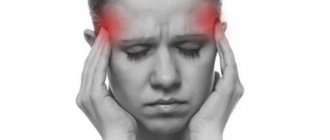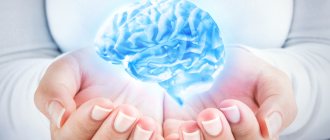The article was verified by doctors at Euromed Clinic✅
Loss of taste and smell, confusion, severe headaches and dizziness after coronavirus - all these and other symptoms indicate damage to the central nervous system and impaired brain function .
Scientists have conducted a number of studies that have proven the direct impact of the SARS-CoV-2 virus on the mental and neurological state of patients.
In addition to disorders of the central nervous system during the course of the disease, some patients who have fully recovered from COVID-19 experience long-term complications such as depression , anxiety , memory problems , so-called brain fog, and an increased risk of stroke .
Causes of headache and nausea
Among the causes of nausea and headaches are infectious and non-communicable diseases, pathologies of the nervous and cardiovascular systems. Soreness manifests itself when there is insufficient blood flow to the brain, intoxication and other disorders. Constant headache, nausea, dizziness are alarming symptoms that indicate not ordinary fatigue, but dangerous disorders. In this case, you should definitely contact for diagnosis and determine the cause of poor health.
Migraine and nausea
Migraine is an acute headache, often one-sided. It can occur in men and women of any age and is chronic. Among its causes are changes in climatic conditions, stress and fatigue, and attacks can also occur for no apparent reason. Migraine occurs in several stages, each of which is characterized by certain symptoms.
- The prodromal period can last from several hours to several days. During this time, there are no headaches or nausea, but other symptoms occur. The patient feels irritability, fatigue, and frequent mood swings. Deterioration of the digestive system and lack of appetite may also occur.
- Migraine aura is a period of time (from 5 minutes to an hour) that immediately precedes a headache attack. It is observed in 80% of cases, so the patient can know in advance when an attack will begin. Nausea begins without headache, dizziness, decreased hearing and vision. In some cases, the aura can be severe, including speech disturbances and hallucinations.
- A headache attack can last from several hours to several days. The patient has a headache to the point of nausea, and performance decreases. The pain is one-sided, may weaken, but then progress again. Its characteristic localization is the temple area, forehead and orbit.
- Postdromal period - continues for several days after the attack. The patient experiences difficulty concentrating, depression and weakness, and constant drowsiness. After 1–2 days he can return to his usual lifestyle.
Treatment of migraine involves taking specific medications prescribed by a doctor - conventional painkillers are ineffective during an attack. Frequent occurrence of acute pain in the head and nausea is dangerous to health. Migraine is accompanied by a deterioration in blood supply to the brain, so over time it can provoke the development of a heart attack or stroke.
Increased pressure
Headache and nausea with high blood pressure are characteristic symptoms. Normal blood pressure readings are 120/80, but in some cases they can increase. This means that the degree of blood filling of the vessels exceeds their compensatory ability. Chronic hypertension occurs with weakness and decreased elasticity of the arteries, vascular spasm, atherosclerosis, and can also be a consequence of endocrine diseases, including diabetes. The risk of its manifestation increases in old age, in the presence of excess weight, due to poor nutrition and bad habits.
An attack of arterial hypertension is manifested by a complex of characteristic symptoms:
- severe headache and nausea;
- disruption of the digestive system;
- redness of the skin and visible mucous membranes;
- tinnitus, decreased visual acuity;
- heart rhythm disturbance.
An equally dangerous condition is increased intracranial pressure. It is impossible to measure it at home, so it is determined by clinical signs. This indicator includes several components: blood pressure, fluid of the cerebral ventricles and the brain itself. As it increases, the patient has a very headache and nausea, hearing and vision impairment occurs. An increase in both arterial and intracranial pressure poses a great danger. Excessive blood supply to the vessels of the brain can lead to their rupture and the development of hemorrhagic stroke. To correct the condition, it is recommended to take a course of antihypertensive drugs and dosage physical activity.
Low blood pressure
Hypotension is a decrease in blood pressure. In some patients, low levels are considered normal, especially with low body weight. However, if the pressure is reduced by attacks during which the patient begins to have a headache and nausea, the condition is dangerous. Secondary hypotension is a characteristic symptom of various chronic diseases of the endocrine, cardiovascular and other systems. Its reasons include:
- phlebeurysm;
- hypothyroidism - decreased functioning of the thyroid gland;
- insufficiency of the anterior pituitary gland;
- deficiency of fluid, salts and microelements from food;
- heart pathologies;
- taking certain medications that promote fluid removal or cause vasodilation.
During an attack of hypotension, headaches and nausea occur. It can last from several hours to several days, while blood pressure readings are constantly changing. The patient experiences pallor of the skin and mucous membranes, weakness and dizziness. A typical symptom is an increased heart rate, as a compensatory response to insufficient supply of oxygen and nutrients to organs and tissues.
Viral diseases
Respiratory viral infections, influenza and sore throat are common seasonal diseases that affect the respiratory tract. They are manifested by a sore throat, cough and runny nose, increased body temperature and general weakness. However, the first sign may be a headache that causes nausea. It manifests itself when the immune system is activated in response to the introduction and spread of a viral infection. Treatment is aimed at increasing the level of immune defense, as well as preventing further transmission of the virus. Bed rest, drinking plenty of fluids, monitoring body temperature, and taking symptomatic medications against sore throat and runny nose are recommended.
Lyme disease
Borreliosis (Lyme disease) is an infectious disease that can be contracted through a tick bite. With his saliva, the bacterium penetrates the bloodstream and begins to multiply in the human body. After this, an incubation period begins, during which there are no clinical signs. The disease then develops in several stages - it is important to pay attention as early as possible and undergo treatment with antibiotics.
- A characteristic symptom of the first stage is erythema migrans. It is a ring-shaped or solid rounded redness at the site of the tick bite. This sign is sufficient to make a diagnosis and prescribe a course of antibiotic therapy.
- The second stage develops several months after the tick bite. It includes disruptions in the functioning of various organs and systems associated with the spread of bacterial infection. Migrating erythema appears on the skin and quickly increases in size. Pain in the joints, back and limbs is also possible. Myocarditis, an inflammation of the heart muscle, develops less frequently. When the nervous system is damaged, aseptic meningitis develops, which at an early stage manifests itself as an acute headache.
- The third stage poses a danger to the patient's life. It develops 6–12 months after a tick bite, in the absence of timely treatment. Its typical manifestation is disseminated encephalomeningitis, inflammation of the brain and its membranes. MRI reveals areas of sclerosis with a typical clinical picture. The patient has a headache, nausea, and pressure in the temple area. Impaired memory and attention are possible, and the risk of stroke increases.
The most effective diagnostic method is a blood test to determine antibodies to the pathogen. However, they appear no earlier than 3 weeks after the tick bite, most often within 4–6 weeks. For this reason, erythema migrans is a reason to start antibiotic therapy, regardless of the results of the blood test. Some patients deny the fact of a tick bite, but taking antibiotics is recommended in any case.
Neoplasms
Brain tumors are one of the most dangerous causes of headaches and nausea for a long time. They can be benign or malignant, primary or represent metastases of other neoplasms. Tumors are formed from cells directly in the brain tissue, meninges, and cranial nerves. Pituitary tumors are isolated separately.
In the early stages, the patient constantly has a headache and nausea. Further additional clinical signs are determined:
- acute headache that does not go away after taking painkillers;
- nausea during a headache - it is not associated with food intake, physical activity and other factors;
- dizziness, fainting;
- convulsions, which most often occur in the upper extremities;
- deterioration of attention, the appearance of memory lapses;
- impaired coordination of movements;
- hearing, vision and speech disorders up to the loss of these functions.
Treatment tactics are selected individually. This takes into account the type of tumor and its location, tendency to rapid growth and malignancy. Neoplasms are removed surgically and, if necessary, radiation therapy is performed. It is important to start treatment in the early stages and not wait for the tumor to increase in size.
Meningitis
Meningitis is a dangerous disease in which inflammation of the membranes of the brain develops. It can be serous, purulent, viral or bacterial in origin. Characteristic symptoms are headache, nausea, increased body temperature to critical levels. Inflammation of nerve tissue can lead to loss of hearing and vision, motor function, memory loss, and death. Treatment is prescribed after identifying the pathogen and is aimed at eliminating it and maintaining brain function.
Other reasons
It is important to understand whether headaches and nausea can occur without dangerous diseases. These symptoms also occur periodically in a healthy person. They can be the result of a number of conditions:
- chronic fatigue, stress, lack of sleep;
- change in climatic conditions - often headaches and nausea after moving, during the adaptation period;
- food poisoning;
- toxicosis in early pregnancy;
- abnormal physical activity;
- poor diet with a predominance of fatty foods;
- bad habits, smoking and drinking alcohol.
If such symptoms (headache and nausea) appear one-time, are easily eliminated by rest and taking painkillers, there is no reason to worry. Doctors at the Clinical Institute of the Brain recommend that you seek examination if they persist for a long time or appear frequently for no apparent reason. If you have a headache and nausea for a week, this is not normal and requires medical advice.
How coronavirus affects the human brain
Scientists around the world, based on the results of MRI diagnostics of patients with coronavirus and data from pathological studies of sick patients who died from COVID-19, conclude that Covid significantly affects the human brain.
How the new type of coronavirus infects cells in the brain and spinal cord has not yet been fully studied. But it has already been proven that the SARS-CoV-2 penetrates host cells through the interaction of its own S protein with the human ACE2 . Thus, on the cells of the terminal nerve located next to the olfactory epithelium of the nose, there are a large number of ACE2 receptors.
Presumably, the SARS-CoV-2 virus enters the brain using terminal nerve cells.
Scientists conducted studies directly on brain cells and came to the conclusion that neurons and cells of the brain and spinal cord - astrocytes - are also susceptible to infection through the mechanism of coronavirus binding to ACE2 receptors. This means that virus particles penetrate into brain cells and cause disruption of its functioning.
traces of viral proteins were found in the brain tissue of infected patients . Thus, coronavirus, entering brain cells, leads to inflammation of brain tissue and neuronal degeneration (death of neurons and loss of connections between them).
Important! Information from the article cannot be used for self-diagnosis and self-medication! Only a doctor can prescribe the necessary examinations, establish a diagnosis and draw up a treatment plan during a consultation!
There is an assumption that the SARS-CoV-2 virus can enter the brain through blood vessels. Researchers have found that Covid affects the blood vessels of the brain by detecting virus particles in the walls of blood vessels. Scientists have determined how Covid affects blood vessels by studying post-mortem human brain tissue.
It turned out that the ACE2 protein, which the coronavirus binds to, is widely represented in all blood vessels of the frontal cortex of the brain. There is a blood-brain barrier between the blood and brain cells. Its main function is to protect nervous tissue from microorganisms and toxins circulating in the blood. Researchers have found that in the presence of the S protein of the SARS-CoV-2 virus, the permeability of the blood-brain barrier is disrupted. One of the main symptoms confirming this fact is hyposmia or anosmia (partial or complete loss of smell).
The results of MRI diagnostics of patients who have had COVID-19 indicate microstrokes and leukoencephalopathy (damage to the white matter that forms the basis of the brain), leading to the destruction of the protective layer of neurons in the central and/or peripheral nervous system.
Research has shown that coronavirus significantly affects cellular aging, thereby accelerating neurodegenerative pathologies (gradual decrease in the number of nerve cells), such as Parkinson's disease, Alzheimer's disease, multiple sclerosis and others.
The state of the human nervous system is also affected by impaired cerebral circulation, oxygen starvation, and respiratory failure, which occurs against the background of damage to the human lungs by the SARS-CoV-2 virus.
All these complications on the brain after coronavirus lead to the development of mental and neurological disorders.
Diagnostic methods
Signs such as headache and nausea require evaluation if they occur regularly. The Clinical Brain Institute has all the conditions for a full examination of patients with similar symptoms. The first stage is an examination by a neurologist, during which reflexes are checked and a preliminary diagnosis is made. To obtain an accurate picture, additional examinations are required, which may include:
- blood tests will allow you to determine the presence of an inflammatory process, pathogens of bacterial diseases, antibodies to viral infections;
- ultrasound diagnostics of the vessels of the head and neck - is carried out with the addition of a contrast agent, as a result of which areas with insufficient blood supply can be detected;
- CT and MRI are techniques that make it possible to obtain a three-dimensional image of any part of the brain and are often prescribed in the diagnosis of tumors.
The Clinical Brain Institute uses individual diagnostic programs. They will only include those tools that are shown in each individual case. The Institute has modern equipment; its use allows obtaining the most accurate data in a short time.
Treatment tactics
After determining the cause of headache and nausea, a treatment regimen is selected. It may include several stages aimed at eliminating the underlying cause and alleviating the patient's condition. Doctors at the Clinical Brain Institute monitor the effectiveness of treatment at every stage and supervise the process until complete recovery.
- Drug treatment is the main stage. Painkillers and antispasmodics may be prescribed, as well as drugs to regulate blood pressure. If a bacterial infection is determined, a course of antibiotics is indicated.
- Physiotherapy is a set of techniques aimed at improving blood circulation and nutrition of the brain. They are based on the irritating effect of using electric current, magnetic and laser radiation. The procedures are carried out in a course and are indicated only during the period of chronic disease.
- Surgical treatment is necessary to remove tumors, aneurysms and other growths that put pressure on nerve tissue and cause headaches. The effectiveness of the operation is determined by the timeliness of its implementation, as well as treatment during the recovery period.
The Clinical Brain Institute diagnoses and treats diseases that are accompanied by headaches and nausea. Doctors recommend not to self-medicate and contact immediately if you feel worse. These signs may not pose a threat to life and health, but in some cases they indicate serious pathologies that require timely medical attention.
Treatment methods
The treatment method for high or low blood pressure, nausea, and headache depends on the exact diagnosis. It is prescribed only based on diagnostic results and often involves taking specific medications. It is important to understand that independent selection of medications can aggravate the situation and lead to undesirable consequences.
- Drug treatment is the main stage of therapy. The doctor selects medications to correct blood pressure for hyper- or hypotension and describes in detail the regimen for taking them. You may also need a course of vitamins, and for chronic hypertension, diuretics.
- Diet is a necessary condition for high or low blood pressure, as well as for atherosclerosis. The patient needs to give up fried foods and sweets, limit the intake of salt and fast carbohydrates.
- Work and rest schedule is one of the main points. It is important to ensure a good night's sleep and make time for light physical activity. These conditions will help stabilize blood pressure and improve the functioning of the cardiovascular system.
Clinically, the Brain Institute specializes in the diagnosis and treatment of disorders that are accompanied by headache, nausea, blood pressure, and general deterioration of well-being. Experienced specialists, modern equipment, highly qualified personnel are the main advantages of the center. Here you can undergo treatment in a hospital setting, under round-the-clock supervision by doctors, and also receive recommendations for maintaining health at home.











